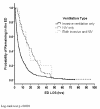Emergency department length of stay for patients requiring mechanical ventilation: a prospective observational study
- PMID: 22494785
- PMCID: PMC3466156
- DOI: 10.1186/1757-7241-20-30
Emergency department length of stay for patients requiring mechanical ventilation: a prospective observational study
Abstract
Background: Recommendations for acceptable emergency department (ED) length of stay (LOS) vary internationally with ≤ 8 h generally considered acceptable. Protracted ED LOS may place critically ill patients requiring mechanical ventilation at increased risk of adverse events as most EDs are not resourced for longitudinal delivery of critical care. Our objective was to quantify the ED LOS for mechanically ventilated patients (invasive and/or non-invasive ventilation [NIV]) and to explore patient and system level predictors of prolonged ED LOS. Additionally, we aimed to describe delivery and monitoring of ventilation in the ED.
Methods: Prospective observational study of ED LOS for all patients receiving mechanical ventilation at four metropolitan EDs in Toronto, Canada over two six-month periods in 2009 and 2010.
Results: We identified 618 mechanically ventilated patients which represented 0.5% (95% CI 0.4%-0.5%) of all ED visits. Of these, 484 (78.3%) received invasive ventilation, 118 (19.1%) received NIV; 16 received both during the ED stay. Median Kaplan-Meier estimated duration of ED stay for all patients was 6.4 h (IQR 2.8-14.6). Patients with trauma diagnoses had a shorter median (IQR) LOS, 2.5 h (1.3-5.1), compared to ventilated patients with non-trauma diagnoses, 8.5 h (3.3-14.0) (p <0.001). Patients requiring NIV had a longer ED stay (16.6 h, 8.2-27.9) compared to those receiving invasive ventilation exclusively (4.6 h, 2.2-11.1) and patients receiving both (15.4 h, 6.4-32.6) (p <0.001). Longer ED LOS was associated with ED site and lower priority triage scores. Shorter ED LOS was associated with intubation at another ED prior to transfer.
Conclusions: While patients requiring mechanical ventilation represent a small proportion of overall ED visits these critically ill patients frequently experienced prolonged ED stay especially those treated with NIV, assigned lower priority triage scores at ED presentation, and non-trauma patients.
Figures
Comment in
-
Mechanical ventilation in emergency departments: non invasive or invasive mechanical ventilation. Where is the answer?Scand J Trauma Resusc Emerg Med. 2012 Jun 26;20:40. doi: 10.1186/1757-7241-20-40. Scand J Trauma Resusc Emerg Med. 2012. PMID: 22734972 Free PMC article.
Similar articles
-
A "Code ICU" expedited review of critically ill patients is associated with reduced emergency department length of stay and duration of mechanical ventilation.J Crit Care. 2017 Dec;42:123-128. doi: 10.1016/j.jcrc.2017.07.011. Epub 2017 Jul 6. J Crit Care. 2017. PMID: 28723586
-
Noninvasive Ventilation for Critically Ill Subjects With Acute Respiratory Failure in the Emergency Department.Respir Care. 2020 Jan;65(1):82-90. doi: 10.4187/respcare.07111. Epub 2019 Oct 1. Respir Care. 2020. PMID: 31575708 Free PMC article.
-
Performance of noninvasive ventilation in acute respiratory failure in critically ill patients: a prospective, observational, cohort study.BMC Pulm Med. 2015 Nov 11;15:144. doi: 10.1186/s12890-015-0139-3. BMC Pulm Med. 2015. PMID: 26559350 Free PMC article.
-
High-flow nasal cannulae for respiratory support in adult intensive care patients.Cochrane Database Syst Rev. 2021 Mar 4;3(3):CD010172. doi: 10.1002/14651858.CD010172.pub3. Cochrane Database Syst Rev. 2021. PMID: 33661521 Free PMC article.
-
Temporal Trends and Predictors of Thirty-Day Readmissions and Emergency Department Visits Following Total Knee Arthroplasty in Ontario Between 2003 and 2016.J Arthroplasty. 2020 Feb;35(2):364-370. doi: 10.1016/j.arth.2019.09.015. Epub 2019 Sep 14. J Arthroplasty. 2020. PMID: 31732370 Review.
Cited by
-
Academic Emergency Medicine Physicians' Knowledge of Mechanical Ventilation.West J Emerg Med. 2016 May;17(3):271-9. doi: 10.5811/westjem.2016.2.29517. Epub 2016 Apr 26. West J Emerg Med. 2016. PMID: 27330658 Free PMC article.
-
Predictive model for daily risk alerts in sepsis patients in the ICU: visualization and clinical analysis of risk indicators.Precis Clin Med. 2025 Feb 8;8(1):pbaf003. doi: 10.1093/pcmedi/pbaf003. eCollection 2025 Mar. Precis Clin Med. 2025. PMID: 40041421 Free PMC article.
-
Mechanical ventilation in emergency departments: non invasive or invasive mechanical ventilation. Where is the answer?Scand J Trauma Resusc Emerg Med. 2012 Jun 26;20:40. doi: 10.1186/1757-7241-20-40. Scand J Trauma Resusc Emerg Med. 2012. PMID: 22734972 Free PMC article.
-
Duration of Mechanical Ventilation in the Emergency Department.West J Emerg Med. 2017 Aug;18(5):972-979. doi: 10.5811/westjem.2017.5.34099. Epub 2017 Jul 11. West J Emerg Med. 2017. PMID: 28874952 Free PMC article.
-
Invasive Mechanical Ventilation in California Over 2000-2009: Implications for Emergency Medicine.West J Emerg Med. 2015 Sep;16(5):696-706. doi: 10.5811/westjem.2015.6.25736. Epub 2015 Oct 20. West J Emerg Med. 2015. PMID: 26587094 Free PMC article.
References
Publication types
MeSH terms
Grants and funding
LinkOut - more resources
Full Text Sources
Medical


